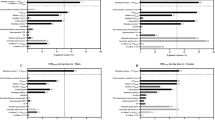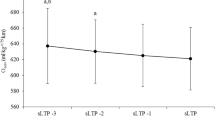Summary
The current investigation was designed to determine which factor or what combination of factors would best account for distance running performance in middle-aged and elderly runners (mean age 57.5 years SD±9.7) with heterogeneous training habits. Among 35 independent variables which were arbitrarily selected as possible prerequisites in the distance running performance of these runners, oxygen uptake\((\dot V_{O_2 } )\) at lactate threshold (LT) (r=0.781∼0.889), maximal oxygen uptake\((\dot V_{O_{2max} } )\) (r=0.751∼0.886), and chronological age (r=−0.736∼−0.886) were found to be the 3 predictor variables showing the highest correlations with the mean running velocity at 5 km (V 5 km), 10 km (V 10 km), and marathon (V M). When all independent variables were used in a multiple regression analysis, any 3 or 4 variables selected from among\(\dot V_{O_2 } \) at LT, chronological age, systolic blood pressure (SBP), atherogenic index (AI), and Katsura index (KI) were found to give the best explanation ofV 5 km,V 10 km, orV M in a combined linear model. Linear multiple regression equations constructed for predicting the running performances were:V 5 km=0.046X 1−0.026X 2−0.0056X 3+5.17,V 10 km=0.028X 1−0.028X 2−0.190X 4−1.34X 5+6.45, andV M=−0.0400X 2−0.324X 4−1.16X 5+7.36, where\(X_1 = \dot V_{O_2 } \) at LT (ml·min−1·kg−1),X 2 = chronological age,X 3=SBP,X 4=AI, andX 5=KI. We suggest that distance running performance of middle-aged and elderly runners could be predicted with a relatively high accuracy by a single predictor of\(\dot V_{O_2 } \) at LT or\(\dot V_{O_{2max} } \), or by a combination of either of these predictors with more easily measurable indices such as age, AI, KI, or SBP. The prediction equations which have been developed can be applied to a larger population of middle-aged and elderly runners.
Similar content being viewed by others
References
Allen WK, Seals DR, Hurley BF, Ehsani AA, Hagberg JM (1985) Lactate threshold and distance-running performance in young and older endurance athletes. J Appl Physiol 58:1281–1284
Ander MM, Castelli WP (1980) Elevated high-density lipoprotein levels in marathon runners. JAMA 243:534–536
Beaver WL, Wasserman K, Whipp BJ (1985) Improved detection of lactate threshold during exercise using a log-log transformation. J Appl Physiol 59:1936–1940
Brooks GA (1985) Anaerobic threshold: review of the concept and directions for future research. Med Sci Sports Exerc 17:22–31
Choquette G, Ferguson RJ (1973) Blood pressure reduction in “borderline” hypertensives following physical training. Can Med Assoc J 108:699–703
Conley DL, Krahenbuhl GS (1980) Running economy and distance running performance of highly trained athletes. Med Sci Sports Exerc 12:357–360
Costill DL (1967) The relationship between selected physiological variables and distance running performance. J Sports Med Phys Fitness 7:61–66
Costill DL, Branam G, Eddy D, Sparks K (1971) Determinants of marathon running success. Int Z Angew Physiol 29:249–254
Davis JA, Frank MH, Whipp JH, Wasserman K (1979) Anaerobic threshold alterations caused by endurance training in middle-aged men. J Appl Physiol 46:1039–1046
di Prampero PE, Atchou G, Bruckner JC, Moia C (1986) The energetics of endurance running. Eur J Appl Physiol 55:259–266
Farrell PA, Wilmore JH, Coyle EF, Billing JE, Costill DL (1979) Plasma lactate accumulation and distance running performance. Med Sci Sports 11:338–344
Foster C, Costill DL, Daniels JT, Fink WJ (1978) Skeletal muscle enzyme activity, fiber composition and\(\dot V_{O_{2max} } \) in relation to distance running performance. Eur J Appl Physiol 39:73–80
Hagberg JM, Coyle EF (1983) Physiological determinants of endurance performance as studied in competitive race-walkers. Med Sci Sports Exerc 15:287–289
Hurley BF, Hagberg JM, Allen WK, Seals DR, Young JC, Cuddihee RW, Holloszy JO (1984) Effect of training on blood lactate levels during submaximal exericse. J Appl Physiol 56:1260–1264
Ivy JL, Withers RT, Van Handel PJ, Elger DH, Costill DL (1980) Muscle respiratory capacity and fiber type as determinants of the lactate threshold. J Appl Physiol 48:523–527
Kumagai S, Tanaka K, Matsuura Y, Matsuzaka A, Hirakoba K, Asano K (1982) Relationships of the anaerobic threshold with the 5-km, 10-km, and 10-mile races. Eur J Appl Physiol 49:13–23
LaFontaine TP, Londeree BR, Spath WK (1981) The maximal steady state versus selected running events. Med Sci Sports Exerc 13:190–192
Lehtonen A, Viikari J (1978) Serum triglycerides and cholesterol and serum high-density lipoprotein cholesterol in highly physically active men. Acta Med Scand 204:111–114
Londeree BR, Ames SA (1975) Maximal steady-state versus state of conditioning. Eur J Appl Physiol 34:269–278
Palgi Y, Gutin B, Young J, Alejandro D (1984) Physiologic and anthropometric factors underlying endurance performance in children. Int J Sports Med 5:67–73
Pavlou KN, Steffee WP, Lerman RH, Burrows BA (1985) Effects of dieting and exercise on lean body mass, oxygen uptake, and strength. Med Sci Sports Exerc 17:466–471
Powers SK, Dodd S, Deason R, Byrd R, McKnight T (1983) Ventilatory threshold, running economy, and distance running performance of trained athletes. Res Q Exerc Sport 54:179–182
Rotkis TC, Cote R, Coyle E, Wilmore JH (1982) Relationship between high density lipoprotein cholesterol and weekly running mileage. J Cardiac Rehab 2:109–112
Saltin B, Astrand PO (1967) Maximal oxygen uptake in athletes. J Appl Physiol 23:353–358
Sjödin B, Jacobs I (1981) Onset of blood lactate accumulation and marathon running performance. Int J Sports Med 2:23–26
Tanaka K, Matsuura Y (1982) A multivariante analysis of the role of certain anthropometric and physiological attributes in distance running. Ann Hum Biol 9:473–482
Tanaka K, Matsuura Y (1984) Marathon performance, anaerobic threshold, and onset of blood acetate accumulation. J Appl Physiol 57:640–643
Tanaka K, Matsuura Y, Moritani T (1981) A correlational analysis of maximal oxygen uptake and anaerobic threshold as compared with middle and long distance performance. Jpn J Phys Fitness Sports Med 30:94–102
Tanaka K, Matsuura Y, Kumagai S, Matsuzaka A, Hirakoba K, Asano K (1983) Relationships of anaerobic threshold and onset of blood lactate accumulation with endurance performance. Eur J Appl Physiol 52:51–56
Tanaka K, Matsuura Y, Matsuzaka A, Hirakoba K, Kumagai S, Sun US, Asano K (1984) A longitudinal assessment of anaerobic threshold and distance-running performance. Med Sci Sports Exerc 16:278–282
Tanaka K, Yoshimura T, Okuda T, Konishi Y, Sumida S, Demura S, Okada K (1986) Physiological alterations in obese women: the effects of caloric restriction plus physical training at an intensity corresponding to or above anaerobic threshold. Bull Phys Fitness Res Inst 62[Suppl]:26–40 (in Japanese)
Wilmore JH, Brown CH, Davis JA (1977) Body physique and composition of the female distance runners. Ann NY Acad Sci 301:764–776
Wyndham CH, van Rensburg AJ, Benade AJS (1969) The physiological requirements for world-class performance in endurance running. S Afr Med J 43:996–1002
Yoshida T, Chida M, Ichioka N, Suda Y (1987) Blood lactate parameters related to aerobic capacity and endurance performance. Eur J Appl Physiol 56:7–11
Author information
Authors and Affiliations
Additional information
Data were collected at the Human Performance Laboratory, Hiroshima University
Rights and permissions
About this article
Cite this article
Tanaka, K., Takeshima, N., Kato, T. et al. Critical determinants of endurance performance in middle-aged and elderly endurance runners with heterogeneous training habits. Europ. J. Appl. Physiol. 59, 443–449 (1990). https://doi.org/10.1007/BF02388626
Accepted:
Issue Date:
DOI: https://doi.org/10.1007/BF02388626




